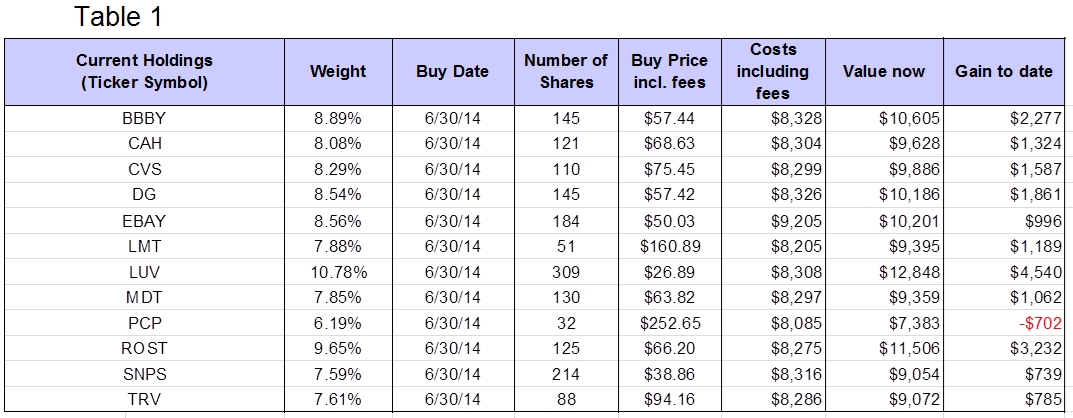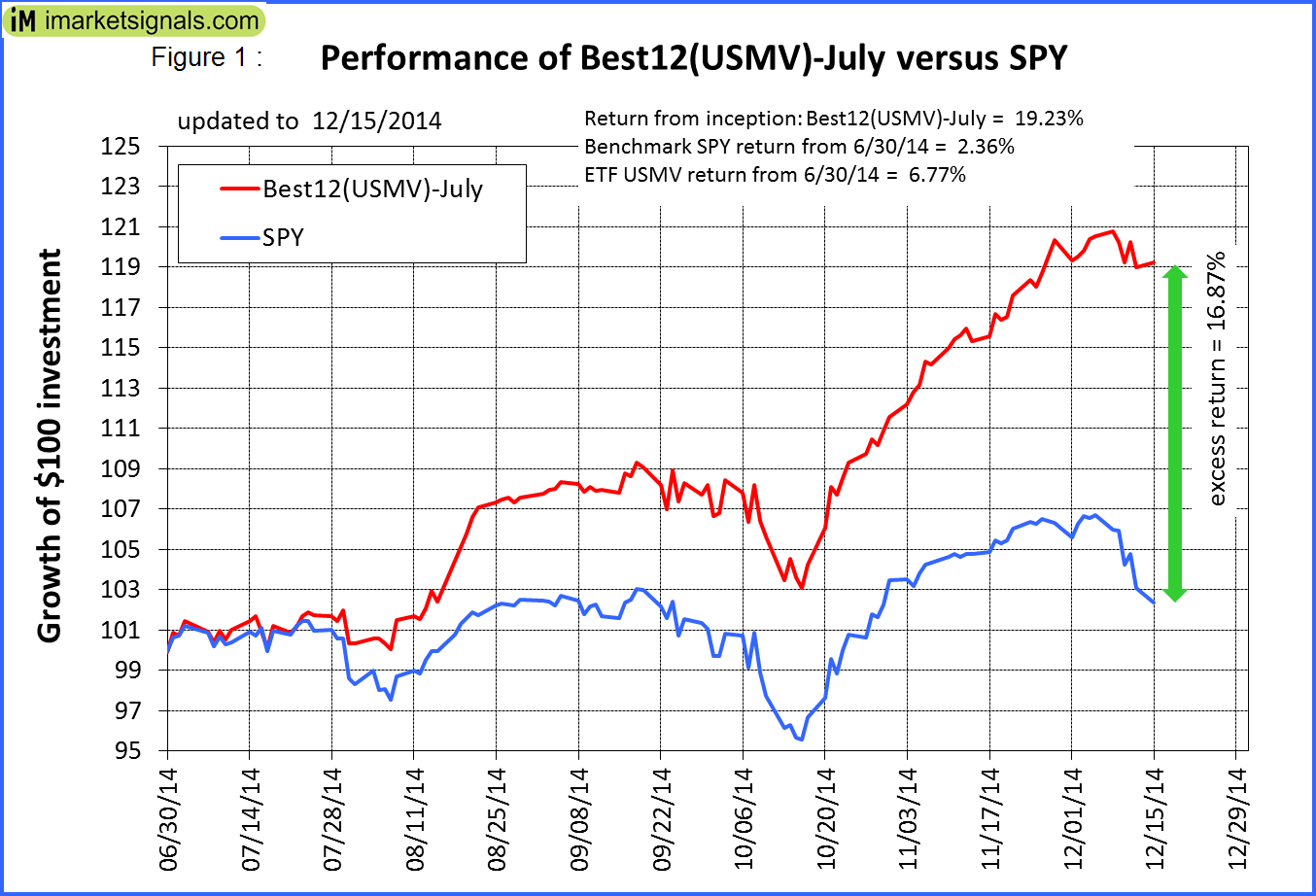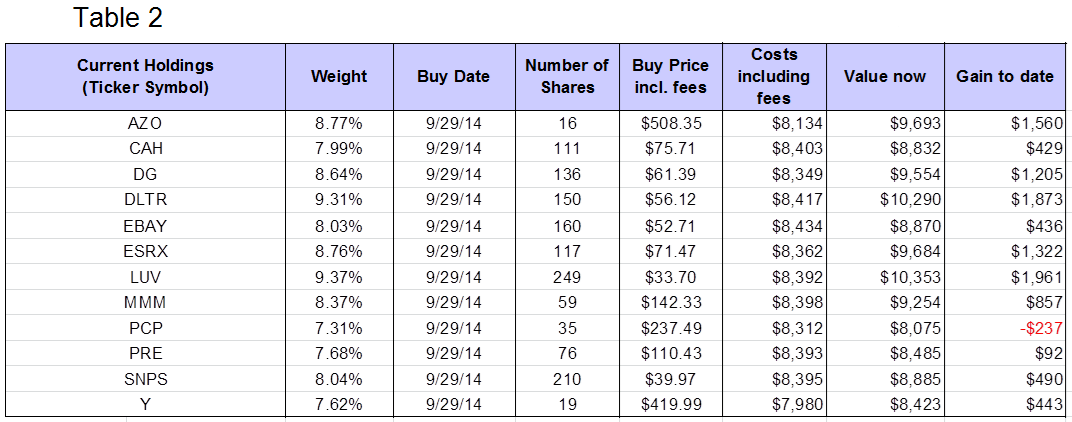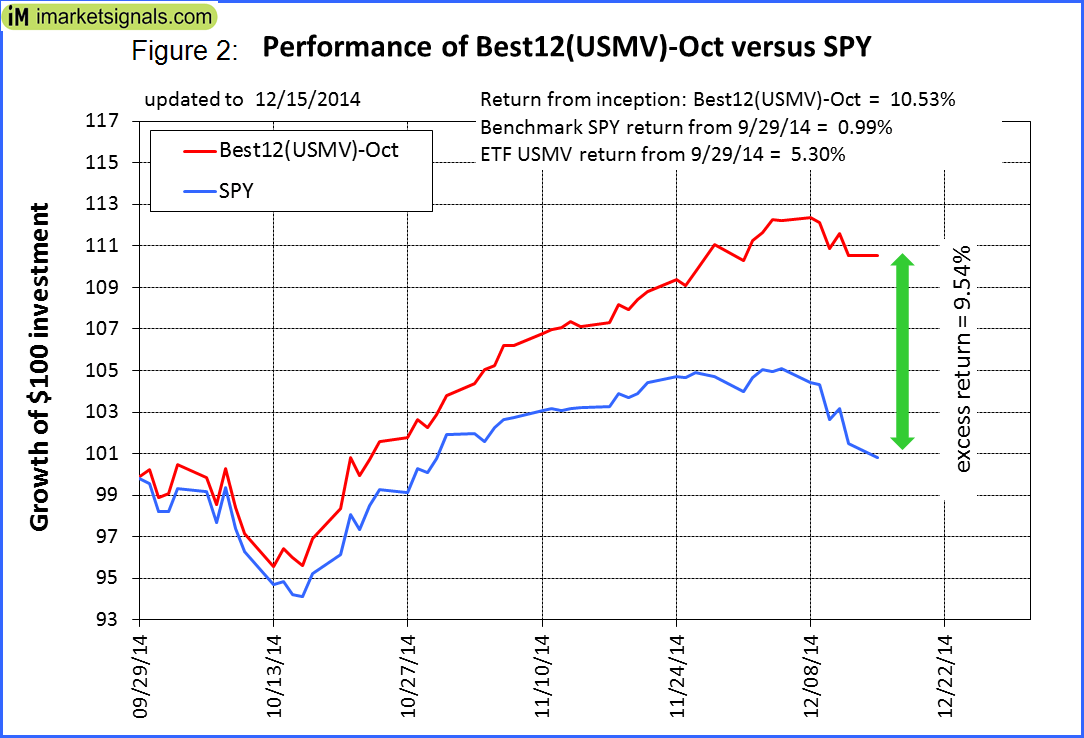The backtest reported in this article showed that ranking the holdings of USMV, the iShares MSCI USA Minimum Volatility ETF, and selecting a portfolio of the 12 top ranked stocks, provided higher returns for the buy&hold portfolio than for the underlying ETF. To test these findings out-of-sample we launched the Best12(USMV)-July-2014on Jun-30-2014 and the first sister model Best12(USMV)-Oct-2014 on Sep-29-2014. Holdings and performance have been published weekly on our website since then. So far to Dec-15-2014 these portfolios have gained 19.2% (6.8%) and 10.5% (5.3%), respectively. (USMV gains are in brackets.) The test will be expanded by the launch on Jan-5-2015 of the second of the three sister models quarterly displaced, the Best12(USMV)-Jan-2015, which again will consist of the 12 highest ranked stocks of the then point-in-time holdings of USMV.
Eventually there will be four quarterly displaced Best12(USMV) models at iMarketSignals to check whether the out-of-sample (OOS) performances of the models exceeds those of USMV over the same periods. Only when the OOS periods are long enough can one decide whether this is a profitable investment strategy. One can probably assume this to be the case if by the end of next year the combined returns of the models is indeed significantly higher than the combined returns of USMV for the corresponding periods. Although the performance of the two models have been considerably better than that of USMV, one should not commit capital in the expectation that strategies that worked well in-sample, and for a few months OOS, are therefore also bound to do well in the future.
Backtest Parameters
It is relatively simple to “overfit” an investment strategy so that it performs well in-sample, but the more complex a model is, the higher the likelihood of the OOS performance to underperform the backtest’s results. Therefore a simple algorithm with only a few parameters was chosen, with buy- and sell rules kept to a minimum, details of which were provided in the original article. The model should also be tax-efficient because the holding period for each stock will normally be at least one year long.
Current Holdings and Return to Dec-15-2014 for Best12(USMV)-July-2014
Of the portfolio’s initial holdings of 12 stocks, 11 of them gained value since inception on Jun-30-14, with the portfolio showing a 19.23% return to Dec-15, while iShares’ USMV gained 6.77% over the same period. A starting capital of $100,000 at inception grew to $119,230, with fees and slippage accounted for.
Table 1 below shows the current holdings, unchanged since inception, and return for each position.
The performance graphs of $100 invested in the Best12(USMV) and SPY (the ETF tracking the S&P500), is shown below, with the red graph indicating the value of Best12(USMV)-July-2014 and the blue graph depicting the value of SPY.
Current Holdings and Return to Dec-15-2014 for Best12(USMV)-Oct-2014
Of the portfolio’s initial holdings of 12 stocks, 11 of them gained value since inception on Sep-29-14, with the portfolio showing a 10.53% return to Dec-15, while iShares’ USMV gained 5.30% over the same period. A starting capital of $100,000 at inception grew to $110,530, with fees and slippage accounted for.
Table 2 below shows the current holdings, unchanged since inception, and return for each position.
The performance graphs of $100 invested in the Best12(USMV) and SPY (the ETF tracking the S&P500), is shown below, with the red graph indicating the value of Best12(USMV)-July-2014 and the blue graph depicting the value of SPY.
Following the Models
At our website, the weekly performance update could be followed already from July 2014 onward. It was originally predicted that a 12-stock model should outperform USMV, which the results of the July and October models so far confirm. (The weekly updates can also be viewed by non-subscribers to iM in the archive section, delayed by a few weeks.)
To track performance over an extended OOS period we will be adding, additional to the Jul-2014 and Oct-2014 models, another two similar models, the Jan-2015 and Apr-2015 models. At inception each model will have a 12-stock portfolio selected from the point-in-time holdings of USMV.
The universe from which stocks are selected will be updated every three months for each model with the universe corresponding to the then current holdings of USMV. Current holdings of the models, which may not be included in the new universe, will be added to the universe. This will ensure that stocks are not sold because they may be omitted from future holdings of USMV, and the models can keep their holdings for at least one year as stipulated by the sell rules.
It is expected that by April 2015 the combined stock holdings of the four models will be about 20% of the holdings of USMV, about 30 different stocks. The portfolio is expected to show better returns than USMV, provided that the OOS performance continuous to confirm the backtest’s results.
Appendix
Combined Holdings
The combined models hold 18 different stocks of which 6 are represented in both models as shown in the table below.
| Combined Holdings of Best12(USMV)-July and Best12(USMV)-Oct | ||
| Ticker | Nr. of times in combination |
Sector |
| AZO | 1 | Consumer Discretionary |
| BBBY | 1 | Consumer Discretionary |
| DG | 2 | Consumer Discretionary |
| DLTR | 1 | Consumer Discretionary |
| ROST | 1 | Consumer Discretionary |
| CVS | 1 | Consumer Staples |
| PRE | 1 | Financials |
| TRV | 1 | Financials |
| Y | 1 | Financials |
| CAH | 2 | Health Care |
| ESRX | 1 | Health Care |
| MDT | 1 | Health Care |
| LMT | 1 | Industrials |
| LUV | 2 | Industrials |
| MMM | 1 | Industrials |
| PCP | 2 | Industrials |
| EBAY | 2 | Information Technology |
| SNPS | 2 | Information Technology |





My understanding is that if a stock drops 10% from its previous high it is sold in the model. PCP was part of the June 29, 2014 selections. It traded at 260 on July 14, 2014 and 221.85 on Nov 5, 2014. That is a 14.6% drop from its previous high. I probably misunderstand something. If so, please tell me what I am not understanding and why the stock was not sold. Also, it seems to me if the stock market drops 15%, 20%, 15% or more most if not all the stocks will drop 10% from their previous high. If a stock is sold in the model what is done with the cash. Is it split between the remaining positions or is it held as cash and, if not one of these two, what?
I meant if the market drops 15%, 20%, 25% or more
in the last question.
I just reread the piece in Advisors Perspectives and you say you only sell if a stock drops 15% from the previous high. So you would not have sold PCP.
This still leaves the question of what you do with the cash if a position is sold before one year’s time and what you would do if many stocks drop 15% because the market drops 25% of more like it did in 2000-2002 and 2007-2009.
Can you help?
Apologies for missing your comments and not replying sooner.
The models are re-balanced every 2 weeks. If a stock is sold (which has so far not happened in the last 6 months) then the proceeds are invested in the the highest ranked stock of the universe which is not part of the current holdings. The model always wants to hold 12 different stocks.
The model is not hedged and there is no market timing either. If the market tanks and a number of stocks decline by more than 15% then they will all be sold and replaced with the highest ranked stocks in the universe. So the model is always fully invested, same as the ETF USMV whose stocks make up the universe from which the model selects.
Thanks. Do you plan to continue to offer the quarterly 12 stocks portfolios beyond early Apr and Jul of this year?
The third sister model, the Best12(USMV)Q1-Investor model was launched today, 1/5/15. The fourth Best12(USMV)Q2-Investor model will be launched Monday 4/6/15. After that there will be four models quarterly displaced and we will continue publishing signals for all 4 models weekly. All models get rebalanced after 1 year.
Thus the July model, the Best12(USMV)Q3-Investor, will be rebalanced for the first time early in July 2015, the Q4 will be rebalanced early in October 2015, and so on. We have no plan to discontinue these 4 models, but there will be no new ones.
Our objective is to have confirmation that the selected group of top stocks from USMV perform better than the ETF USMV itself.
Should PCP have been sold in the first two 12 stock portfolios and replaced with another stock? If so, what was the date that this should have taken place and the stock it should have been replaced with. If this transaction took place, I probably missed an email you sent. Please tell me what email would this have been communicated in so I can make sure I am signed up for it.
On Monday 1-19-15 the following was emailed to members who selected “Sunday Holdings Email” from the Email Service selection box.
iM-Best12(USMV)Q4-Investor sell PCP – buy QCOM. Reason is that PCP has declined by more than 15% from highest close since position started, it shows a change of -16%.
But USMVq3 also holds PCP and it shows a return of -21% and has been held for 200 days now. The sell rules are identical for all the Best12(USMV)-Investor models. So why has USMVq3 not sold PCP as well? Reason is that the models are rebalanced every 2 weeks, not weekly, and USMVq3 was not rebalanced this week, whereas USMVq4 was, and last week PCP was down -9.1%.